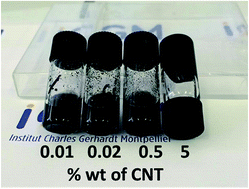Redox bucky gels: mixture of carbon nanotubes and room temperature redox ionic liquids†
Abstract
In the past few years, the design of bucky gels based on ionic liquids has been an attractive field for many applications. The present electrochemical work investigates the first redox bucky gel by cyclic voltammetry and electrochemical impedance spectroscopy. First, the synthesis of a room temperature ionic liquid named 3-TEMPO-1-methylylimidazolium-bis(trifluoromethylsulfonyl)imide (TEMPO-MeImTFSI) was reported (Tg: −31 °C). Then, a redox bucky gel was synthesized based on room temperature redox ionic liquids with carbon nanotubes at a different weight ratio. Electrochemical investigations on this new material were performed using an ultramicroelectrode (to study room temperature redox ionic liquids) and cavity microelectrodes (to study the redox bucky gel). By electrochemical impedance spectroscopy measurement, carbon nanotube percolation was determined to be about 2 wt%. At this ratio, both ionic and electrical conductivities were observed. Moreover, the mechanisms of electron transfer and mass transport inside the redox bucky gel were investigated. Using an ultramicroelectrode, the diffusion shows a succession of self-exchange reactions, named chemical diffusion. Using a cavity microelectrode, the electron transfer kinetics induced by the electro-activity of TEMPO in the bucky gel was evaluated, revealing rapid electron transfer.



 Please wait while we load your content...
Please wait while we load your content...